Tag Archive: visual supports
October 8, 2012
by Robin Parker -

It is National Fire Protection Week October 7-13, 2012. Check Out These 5 Great Tips, Tricks, and Teaching Ideas: Sensory Breaks & Learning Activities Firefighters are being Educated in Auburn On-Line Fire Safety Games for Kids How To Teach and Present Information, Lesson Plans, and Visual Supports for children and adults with Intellectual Disabilities For Teachers and SLPS
Filed under: PrAACtical Thinking
Tagged With: AAC Strategies, Fire Safety, resources, teachers, visual supports
October 3, 2012
by Robin Parker -

Behavior challenges tend to be a major concern of speech-language pathologists, parents, and educators alike. It is the area that is often most nerve wracking for many professionals and families. But once you get a set of strategies that help you have a plan, most challenging behaviors can be reduced. We like to think of challenging behaviors as opportunities 1: for the learner to practice understanding or expression of communication and language and 2: for facilitators/educators to use behavior strategies or learn new ones. So in order to be best prepared for challenging behaviors, start a Communication-Behavior Strategy Tool Kit. Here some powerful tools that will help ALL learners. 3 Power Tools for Communication & Behavior Choice Boards- helps give a learner power but under our guidelines and boundaries. With choice boards, a student learns more communication while having less power struggles/behavior challenges. Opportunity to teach choice making, expression... [Read More...]
Filed under: PrAACtical Thinking
Tagged With: AAC Strategies, Challenging Behavior, choice boards, first-then board, signs, visual supports
September 16, 2012
by Carole Zangari -
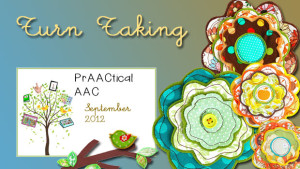
We’re always looking for new ways to represent things visually. Today, we’re sharing an idea from Amy Laurent on helping children take turns. You can view a video explaining the strategy she uses and download the visual support here.
Filed under: PrAACtical Thinking
Tagged With: ASD, intervention, pragmatics, social skills, turn taking, visual supports
September 15, 2012
by Robin Parker -
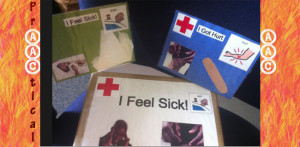
We were looking over the great hospital resources from Patient Provider Communication Forum, Central Coast Children’s Foundation, Dr. Bronwyn Hemsley, and Widgit Software that Carole wrote about and realized that not everyone automatically knows how to talk about pain, illness and injury. We often need to teach the expression of these concepts. We use various types of modeling and create Boxes or Drawers that have items (i.e., bandaids, antiseptic, washcloth, ice buddy, etc) to ‘help with Cuts/Scrapes’ (or any other illness). We have had some fun and lots of practice using these apps to also help the learning process. 5 Apps To Learn and Practice Talking About Pain, Illness, & Injury Don’t forget to model, play, and use the apps often in the teaching process so when they are really needed you will see spontaneous communication and language. Toca Doctor– learning about injury and sickness through fun noncompetitive challenges that involve ‘healing’ the damaged part.... [Read More...]
Filed under: PrAACtical Thinking
Tagged With: Apps, illness, Injury, Medical Resources, pain, visual supports
August 27, 2012
by Carole Zangari -

“How was school?” (Good) “What did you do?” (Nothing) This scenario plays out in many cars and kitchens in the after school hours and it can be hard to know who is more frustrated: the kids for being asked or the parents for not getting satisfactory answers. And still, we repeat the process day after day. Of course, we want to know the fine details of what happened and how our children felt, but in some cases, we’d settle for ANY school-related conversation at all. I’ll be the first to admit that it took me way too long to get the hang of how to get information about my children’s school days, and it seemed like just when I did, pow! They were pre-teens and then teenagers. New rule book. Here are some ‘lessons learned’ along the way about those afterschool conversations and some suggestions for parents of the kids... [Read More...]
Filed under: PrAACtical Thinking
Tagged With: families, home, implementation ideas, schools, visual supports
August 25, 2012
by Robin Parker -
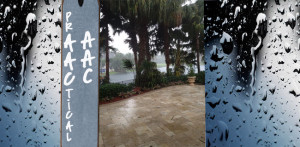
We live in Florida and there are lots of general summer storms. They can be very loud and dark. There are also many hurricane warnings (like now for Hurricane Isaac). Many children and adults with communication challenges can become upset or anxious because of the loud noises, the change in routines, and/or the heightened state of anxiety that is usually around the house or community. Because of this we are often asked to help find visual support resources. Here are some great prepared visual support stories and resources that we use: Bad Weather Tips and Story by Hands in Autism Hurricane Preparedness More Hurricane Preparedness Thunder/Lightning Storms Thunder Box Sometimes though the prepared supports do not meet the needs for specific learners. Here are our tips for developing your own storm visual supports and resources Creating Personal Participation Stories Use language of the story that is at the... [Read More...]
Filed under: PrAACtical Thinking
Tagged With: choice boards, Social Story, Sotrms, visual supports
August 5, 2012
by Carole Zangari -

Cohesion is a tough concept for many of our learners who are developing their AAC skills and struggling to build relationships. In this week’s featured video, Joel Shaul, from Autism Teaching Strategies, discusses how to use two metaphors for building cohesive conversations. One is the idea of links in a chain and the other is the girders of a building. Of course, we are big fans of the use of visual supports whenever we talk and teach. — Although the focus here is learners with ASD, we’ve used this and similar strategies many kinds of learners. Hope you enjoy this informative video. – – – –
Filed under: Video of the Week
Tagged With: Conversation, intervention, resources, visual supports
July 29, 2012
by Carole Zangari -
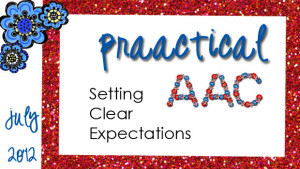
This week we return to the Geneva Centre for Autism for have two short videos from on strategies to support positive behavior. – Enjoy these explanatory videos on Clear Expectations With Visual Rules and Classroom Rules. –
Filed under: Video of the Week
Tagged With: ASD, implementation ideas, intervention, visual supports
July 28, 2012
by Robin Parker -
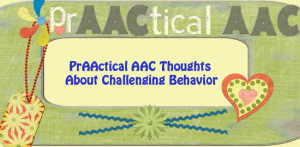
Some PrAACtical AAC thoughts about challenging behavior: I wonder if it is ok to say that we love seeing challenging behavior during speech-language therapy sessions or observations. Well, I said it, both of us do, because if we really ‘listen’ then we can figure out what to teach that will really help our students. We tend to prioritize our goals into High Priority and General Priority. Challenging behavior and the communication message behind it, definitely falls into high priority. This is because challenging behavior in students limits experiences, limits interaction, and overall limits opportunities for people to get to know you. Consider Challenging Behavior through Communication Glasses Is it really Challenging Behavior? behavior that is or can be destructive or hurtful. Examples include but are not limited to: hitting, biting, spitting, throwing, pounding, etc. (Note: we are not talking about poor eye contact or poor attention to task or even laughing... [Read More...]
Filed under: PrAACtical Thinking
Tagged With: Challenging Behavior, communication, positive behavioral supports, visual supports
July 28, 2012
by Robin Parker -
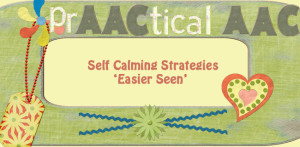
Throughout this month we focused on visual supports & strategies for positive behavior. We have discussed transition supports, environmental arrangements, and consequence mapping. As we wrap up, we don’t want to forget PrAACtical AAC strategies for self-calming. We like to think about self-calming like this- some weeks we need it more than others, some days we need it more than others. We all need self- calming strategies. Whether we vent to a friend, go for a run, knit, take deep breaths, or get a glass of wine (although we are not advocating this), we all use self-calming strategies. It makes a huge difference. Sometimes though helping our students self-calm at times may seem “easier said than done”, but we know it truly is ‘easier when SEEN‘. Self-calming strategies can help before, during, and after behavior challenges . We will often teach and use self calming strategies if we know a potentially stressful situation will... [Read More...]
Filed under: Strategy of the Month
Tagged With: Challenging Behavior, resources, Self-Calming, strategies, visual supports









